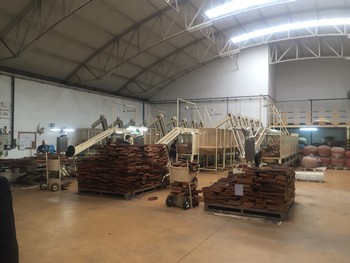Time to Punch Out! (Part 7 in Andy's on-going Portugal travels)
As we pick up the journey of our intrepid hero, our cork bark slabs had been aged to stabilize, boiled and sorted. They now hop a northbound truck to the processing facility in Porto. Many times, slabs that were boiled and sorted on a Monday may be punched as early as Tuesday or Wednesday.
The slabs were all pre-sorted before their journey. For punching, the factory pulls just one grade of slabs to work with on a given time. Men wearing Kevlar gloves grab one slab at a time and run it along a preset jig depending on the length of cork they are producing that day. At Schweiger Vineyards, we traditionally use a 49 mm cork, however in recent years, we started using a 54 mm length cork. Both corks do an equal job of sealing the bottle, but there is a prevailing belief to produce longer corks, you need to source from the better slabs. You rarely see low quality 54 mm corks. Conversely, you rarely see high quality 44 mm corks. These are primarily used for inexpensive, bulk production, factory farm wines.
Ah, but where was I…the freshly cut strips now travel up a conveyer, where they drop into one of several hoppers. Each hopper feeds to an individual M.A. Silva employee who takes one strip at a time, placing it against a stainless steel back stop. Their foot controls the forward/backward motion of a special hollowed out drill. As they work, the drill continuously spins, being driven by a series of belts. When they are ready to punch, they push down their foot, bringing the drill bit into the block, ejecting a freshly cut cork. The placement of the punch has to be very precise. Too close to the belly (inside of the bark) or the bark (outside of the bark) results in an uneven cork that will not seal correctly. Once the worker has punched the maximum corks possible out of a strip, the strip is thrown into a conveyer hopper where it is taken away to be ground up.
I have to stop here for a moment. One really cool thing I learned on this trip is how little waste there is in cork production. These “Holy” strips, once ground up, are placed into bales and loaded onto the trucks that just brought them north. These trucks don’t deadhead back down south; they get filed with this granular cork and head back to the boiling facility where the granules are used to fire the boilers for the next batch of cork slabs.
The final part of the punching process is a polish. The individual corks get a quick brushing with a sanding wheel to ensure that the outer surface is as smooth and even as possible. From here, the corks will move on to sorting, washing, and sorting…to be covered in an upcoming post!
